All about blueberries
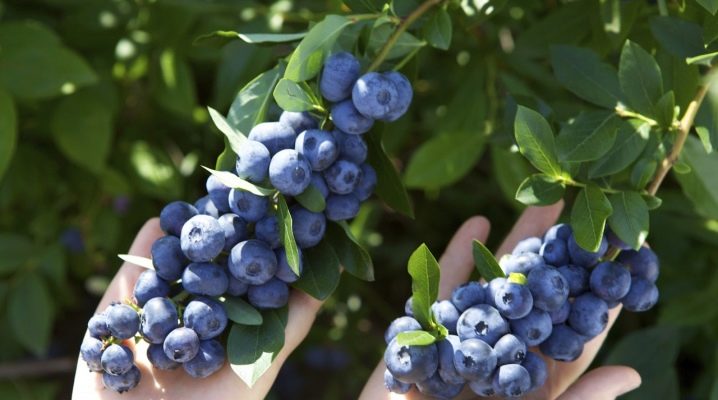
Blueberry (gonobel) is a tasty and healthy berry. At the same time, the culture is unpretentious, planting and caring for it are available even to a novice gardener. In our article, we will dwell in more detail on the features of this plant and talk about the basic requirements of agricultural technology.

general description
Blueberries, by nature, belong to the Heather family, akin to blueberries. It includes undersized (0.3-1 m), as well as tall (1.8-2 m and above) varieties. There are two bush forms:
- ordinary, better known as marsh (marsh);
- tall (popularly called the shield berry).

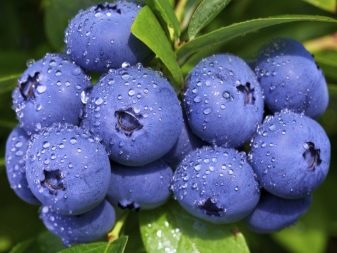
Common blueberry is a perennial and looks like a branched shrub that grows up to 40-60 cm (in the natural environment) or 70-100 cm (in garden forms). It develops best on acidified substrates of peat bogs. The culture can be found in damp conifers and dense deciduous forests. In a cultural form, it spreads throughout Russia: in the tundra, in Siberia, as well as in the Urals and in other regions of the Non-Black Earth Region with a cold or temperate climate. It is very unpretentious, very quickly adapts to a variety of natural and climatic conditions.

The period of active fruiting begins at 10-15 years and lasts for 70-80 years. Each bush is harvested from 200 g to several kilograms of harvest, while productivity is much higher in the rainy season. At the very end of spring or early summer, bell-shaped drooping flowers form on the shoots of last year, and after 40-50 days they are replaced by blue berries up to 10 mm in size.
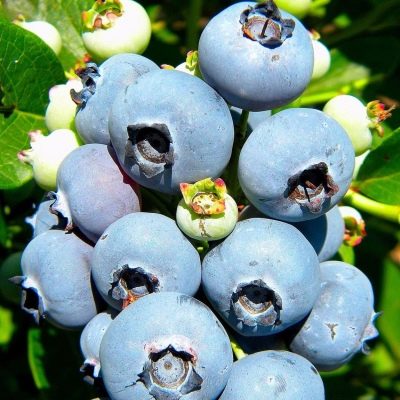
Blueberries are considered to be a common variety. Her homeland is North America. The culture prefers wet wetlands. Under favorable conditions, it grows up to 2-2.5 m both in length and in width.
Flowering begins in late May, and juicy tasty berries begin to ripen in summer. Early varieties are ready in mid-July, mid-season varieties in August, and late varieties in early September. The berries ripen unevenly, after reaching full ripeness, they can hang on the branches for at least 1.5-2 weeks. Up to 3-12 kg are harvested from one bush, the berries are larger than that of an ordinary one - 10-20 mm.

Tall forms are more thermophilic. They do not tolerate excessive moisture and prolonged drought. At temperatures below -25 degrees, the branches freeze over, although with the arrival of spring heat they quickly recover.
Wild and garden types of blueberries have their own differences:
- forest berries grow on swampy land, and garden forms need a substrate with high acidity;
- wild plant fruits look smaller, and cultivated berries are usually large, with fleshy juicy pulp;
- domestic blueberry bushes grow upward, while wild ones spread along the surface of the earth.

Types and varieties
Depending on the timing of ripening, early-, mid- and late-ripening varieties are distinguished. Early varieties are planted in areas with a short warm period. This allows you to harvest the ripe crop before the arrival of frost.


Early
- "Patriot" - a short bush with dense branching and great vigor. The yield from each bush under favorable conditions reaches 7-9 kg. The fruits are soft, up to 20 mm in size, and have excellent taste characteristics.
- "Northland" - unpretentious life form, resistant to external adverse factors. It belongs to undersized varieties, it brings up to 4-6 kg of yield from a bush.Fruits are juicy, sweet, thin peel, medium diameter.
- "Chippewa" - garden form, grows up to 80-100 cm. With proper care, each bush gives up to 2-3 kg of delicious berries. The fruits are light blue, rather large, and the bushes are resistant to cold weather and temperature fluctuations.
- "Spartan" - a high-yielding species, from a bush you can get up to 6-8 kg of berries. The size of the fruits is 15-18 mm, the taste is sweet, with tart notes.
- "River". This shrub allows you to collect up to 8-10 kg of fruit. The berries are dense, juicy, and have a pronounced smell.


Mid-season
Mid-ripening varieties ripen immediately after the early ones, which significantly prolongs the time of consumption of the tasty berry. These varieties are best planted in temperate or warm climates.
- "Legacy" - a low-growing variety of blueberries, bringing up to 10-12 kg of berries from one plant. Branched bush, up to 1.7-2 m high. The crop can be used both for fresh consumption and for canning.
- "Kaz Plishka" - a variety with hard shoots and spherical berries. Ripening begins at the very end of July. Dessert berries, juicy, fragrant. The level of crumbling is low, which makes mechanized collection possible.
- Polaris. This variety gives 6-7 kg of fruit per shrub. Plants are compact, tall. The fruits are juicy, very sweet. Optimal for cultivation in summer cottages, can be grown on an industrial scale.
- "North" - self-fertile species up to 1 m high. Productivity is high, berries grow 17-20 mm in size.

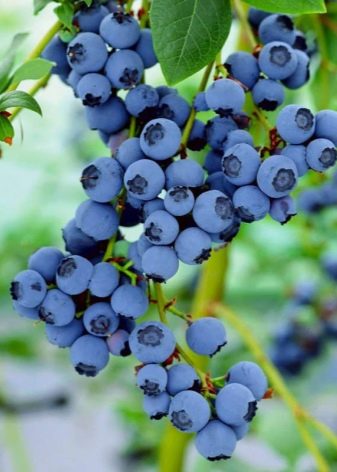
Late ripening
It is advisable to plant late varieties in areas with prolonged warm summers. Such bushes grow and develop most successfully in the southern regions of the country.
- "Nelson" - a tall variety with a height of 1.4-1.7 m. The shoots are quite powerful and dense, the shape of the crown is round, slightly spreading. Fruiting is 5-7 kg per bush.
- Berkeley - a sprawling, vigorous variety, optimal for both industrial and private cultivation. Bushes grow up to 1.9-2.1 m and yield 5-8 kg of harvest. The berries begin to ripen from the second half of August.
- "Boniface". This shrub is distinguished by upright branches. The fruits are round, medium to large in size. Ripening begins in mid-July.
- "Meader". This variety is prized by gardeners for its fast growth and exceptional resistance to insect attacks and diseases. Bushes up to 2 m high are cultivated as fruit or ornamental plantings.
- "Jorma" - a medium-sized plant, growing up to 1.6 m. The berries are juicy and large, ripen throughout August. The frost resistance of the variety corresponds to -27 degrees.

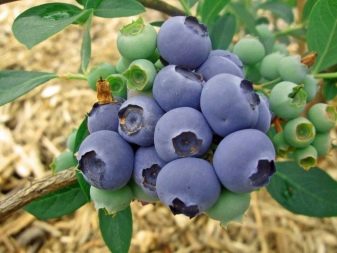
Landing
The process of growing blueberries begins even before the young seedling is placed in the open ground. The productivity of cultivation depends entirely on the quality of the preparation of the site and the readiness of the plant itself for planting. Like the overwhelming majority of fruit plants, the location of planting, the parameters of illumination, the thermal regime and the degree of moisture of the substrate are of fundamental importance.
- Light. Blueberries are light-loving crops. In the absence of sufficient illumination, fruiting decreases, the taste and quality of berries deteriorate. The site is required well-lit by the sun throughout the day. At the same time, it must be protected from wind gusts. A suitable solution would be a place near the house or a fence on the south side.

- Substrate. It is better to plant blueberries away from the garden, since large trees and the described culture become competitors in the water intake.
The soil should be well-drained, moisture-consuming. At the same time, the high occurrence of groundwater does not pose a danger, since the rhizome of the bush is superficial and does not go into the depths.


You should also decide on the timing of planting. If young seedlings are planted with a closed root system, then planting can be carried out from April to October.For bushes with open roots, it is advisable to plant in the fall, so that the seedling has time to adapt to new conditions and take root before the start of a new growing season. Spring planting is permissible.
However, in this case, you can wait for flowering and fruiting only next year.


Garden bed preparation includes standard steps.
- To begin with, form a hole 50 cm deep and 80 cm wide.
- Expanded clay, broken stone or other drainage is poured onto the bottom, it is advisable to mix it with coniferous sawdust or crushed bark of coniferous plants. If possible, add some moss.
- At this stage, it is necessary to feed the substrate with mineral compounds with an increased concentration of nitrogen and sulfur.

After that, you can go directly to the disembarkation. In this case, you must adhere to the basic rules.
- It is best to plant blueberry bushes in rows. Moreover, the distance between them should be about 1.5 m for tall varieties and 1 m for undersized ones.
- It is important to maintain the correct row spacing, as over-thickening of the plantings leads to a reduction in the amount of sun available to each individual bush. This most negatively affects the taste parameters of berries, leads to a weakening of immunity and plant ailments. To prevent this from happening, at least 2 m should be left between the rows, regardless of varietal characteristics.


In the hole prepared for the bush, cover the fertile soil with a slide, place a young seedling on this soil, carefully straighten the roots. Fill the hole with soil, tamp it a little, then pour it intensively with warm water and cover the beds with mulch.

Care
Caring for cultural blueberries is easy. It includes standard agronomic measures.
Watering
The plant prefers abundant irrigation, but do not confuse this with over-watering the soil. Stagnant water is extremely dangerous for the culture. At the same time, exclusively natural precipitation may not be enough to completely moisturize the substrate.
After planting, young blueberries are watered every three days. If the weather is hot and dry, then watering should be increased up to three times in 7 days. For mature bushes, twice irrigation per week is enough.
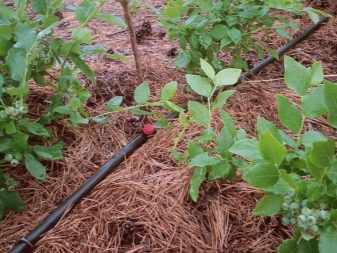

The best solution would be to install a drip irrigation system.
Top dressing
Blueberry feeding includes several stages. First, you need to prepare a nutrient mixture. You can make up a useful fertilizer yourself. And you can also buy complex preparations containing the entire set of micro- and macroelements necessary for the culture in precise dosages. Experienced gardeners usually choose Target or Florovit.
Top dressing is carried out in three stages. The very first falls in the second decade of April, the second is carried out in a month. At the end of July, fertilization is applied for the third time.


If for one reason or another you are forced to shift the schedule, then keep in mind that the addition of nitrogen-containing fertilizers to the soil should be carried out before July, otherwise the bush will not have time to fully prepare for wintering.
Pruning
There are several types of fruit shrub pruning, all of which can be used for cultivated blueberries.
- Formative. Produced in springtime. The basic goal is to form the crown so that the rays of the sun illuminate all the branches and shoots of the shrub.

- Regulatory. It is performed at the end of summer every year, starting from the third or fourth year of the plant's life. At this stage, all old branches are cut, and new growth is also shortened.

- Anti-aging. Every 9-10 years, the bush is cut off almost entirely near the soil itself, leaving only 6-7 young and strong shoots. Such pruning is carried out when there is a decrease in yield and a deterioration in the taste of berries.

Wintering
Blueberries can withstand frosts down to -25 degrees. And even if its shoots are frozen, there is still a high probability that the plant will come to life with the arrival of heat. Nevertheless, such loads adversely affect the condition of blueberries, therefore it is advisable to prepare thoroughly for wintering:
- before subzero temperatures arrive, be sure to carry out abundant water-charging watering;
- Tie the blueberry sprigs, carefully bend them to the ground and attach to the substrate;
- close the trunk circle with mulch (it is best to take coniferous residues, bark or needles);
- cover the shrub with spruce branches or wrap it with agrofibre.


In spring, the shrub can be opened very first, because this plant is not afraid of even return frosts down to -5 degrees.
Reproduction
There are several ways to propagate cultivated blueberries.
- Seeds. Quite a long and laborious technique, in which a good harvest can be expected no earlier than in 8-12 years. Here ripe berries are used, which are dried and then planted in a small trench. After a couple of years, they are transplanted to a permanent site.

- Cuttings. A healthy stalk is separated from the mother plant, placed in a sand box and stored in a cellar or other cool place. After a couple of years, a full-fledged seedling is obtained, fruits on it can be expected within a year after planting in open ground.

- Layers. In spring or summer months, the branch is carefully tilted to the ground, a small fragment of it is sprinkled with soil mixture to create optimal conditions for growing a separate root system. The next season, the sapling with a pruner is separated from the main one and moved to the garden bed.
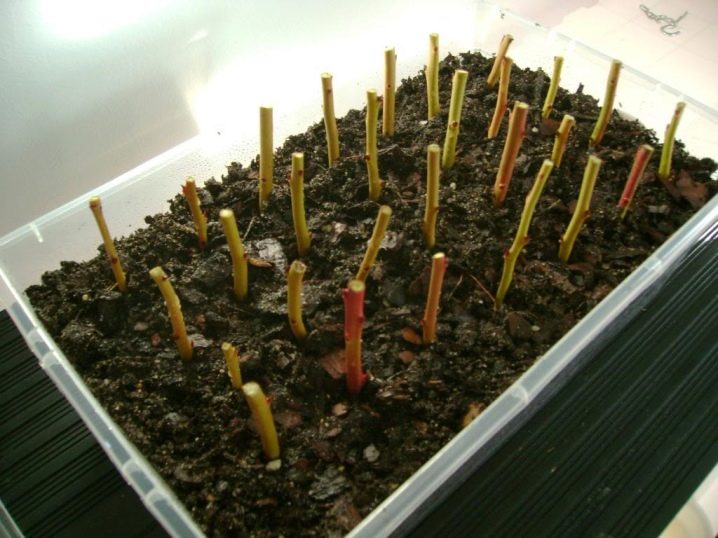
Diseases and pests
Blueberries are susceptible to infection with gray mold, anthracnose, and phomopsis, but stem cancer is considered the most dangerous. The appearance of an ailment is indicated by the appearance of red spots on the leaves, over time they grow and cover all green parts. This disease is incurable, the affected bushes must be uprooted and burned outside the boundaries of the site.
The correct prevention becomes an effective fight against blueberry lesions:
- before the first leaves appear in the spring, and also immediately after they fall in October, spray the shrub itself and a piece of land in the near-stem circle with Bordeaux liquid;
- before flowering, carry out three times treatment with "Fundazol" with an interval of 7-10 days (the same is done after the end of the harvest).

The main pests of blueberries are birds; to protect them from them, shrubs are covered with a net. May beetles cause no less harm. Spraying helps to get rid of insects, although it is more preferable to resort to a mechanical method and collect beetles with larvae by hand.
Interesting Facts
Blueberry fruits are very healthy. They are a storehouse of biologically valuable substances and contain a rich set of vitamins. Berries have antiscorbutic, anti-inflammatory, antipyretic, and general strengthening effects. Blueberries contain vitamins, and berries also contain a lot of flavonoids, anthocyanins and minerals (zinc, selenium, copper and manganese).
The product is rich in natural hormones - phytoestrogens. Blueberry berries taste like a cross between green grapes and blueberries.

Additional facts:
- in America in the summer they organize a number of blueberry festivals, during which they sell all kinds of dishes with berries;
- ripe fruits can be used to color eggs for Easter;
- the leaves of the culture are suitable for tanning leather;
- blueberries are an excellent honey plant.







The comment was sent successfully.